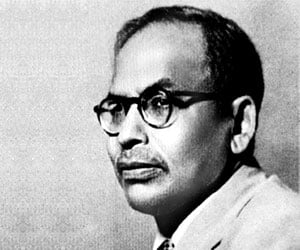Meghnad Saha is the Indian astrologist who did research on changes in the stars and their temperature. He was born in Seoratali in Dhaka in Bangladesh on October 6th, 1893. He was the last of the five children and he developed with the help of studies. His family used to starve with hunger because the money earned by his father was not sufficient for them. His father tried to stop Saha from studying and join him in any work. Teachers of Saha had observed his activeness and asked his father to join in Boarding school with the help of sponsors. Saha had studied well and won many scholarships and went to Dacca to study higher studies. He was dismissed for being against the governor who attended the function. He had joined in another school and got scholarship in that school also.
There are popular people among the teachers who taught Saha like Jagadesh Chandra Bose and PC Ray. Satyandranath was his classmate in Kolkata residency school. After the completion of M.Sc, he was busy with experiments as British government did not give him job. He also taught tuitions and later on, he joined as professor in Kolkata. Saha had explained about ionization while explaining the reason for formation of spectrum. He was also able to explain the temperature and other principles of sun. He was elected for fellow of Royal Society in London. He had done research in spectroscopy and ionosphere while working as professor in Allahabad University. Saha had designed the device which detects the weight and stress of the sun rays. He did research on ancient rocks, radiations from the sun and radio principles. He had started nuclear physics in Kolkata University in 1948.

In 1917, He started his professional career and joined as lecturer at the newly opened University College of Science in Calcutta. He taught Quantum Physics. Along with S.N. Bose, He translated the papers published in German by Einstein and Hermann Minkowski on relativity into English versions. In 1919, American Astrophysical Journal published – “On Selective Radiation Pressure and its Application” – a research paper by Meghnad Saha. He put forward an “onization formula” which explained the presence of the spectral lines. The formula proved to be a breakthrough in astrophysics. He went abroad and stayed for two years. He spent time in research at Imperial College, London and at a research at Imperial College, London and at a research laboratory in Germany. In 1927, Meghnad Saha was elected as a fellow of ‘London’s Royal Society’.
In 1932, Meghnad Saha moved to Allahabad, Uttar Pradesh Academ y of Science was established. He returned to Science College, Calcutta in 1938. During this time, Saha got interested in Nuclear physics, which later was named after him as Saha Institute of Nuclear physics in the curriculum of higher studies of science. Having seen cyclotrons used for research in nuclear physics abroad, he ordered one to be installed in the institute. In 1950, India had its first cyclotron in operation. He invented an instrument to measure the weight and pressure of solar rays. He produced the famous equation, which he called ‘equation of the reaction-isobar for ionization’, which later became known as Saha’s “Thermo-Ionization Equation”.
Saha was the leading spirit in organizing the scientific societies like the ‘National Academy of Science’ (1930), ‘Indian Institute of Science’ (1935), and the ‘ Indian Association for the Cultivation of science’ (1944). The lasting memorial to him is the ‘Saha Institute of Nuclear physics’ founded in 1943 in Calcutta. He was the chief architect of river planning in India. He prepared the original plan for Damodar Valley Project. Meghnad Saha was an Indian astrophysicist who nominated for the ‘Nobel prize’ in physics in 1935-36. In 1952, he was elected as a Member of Parliament for the North-West Calcutta constituency. He was an advocate for the peaceful use of nuclear energy and instrumental in the reformation of the Indian calendar. He died on February 16, 1956 due to a heart attack.


No comments:
Post a Comment